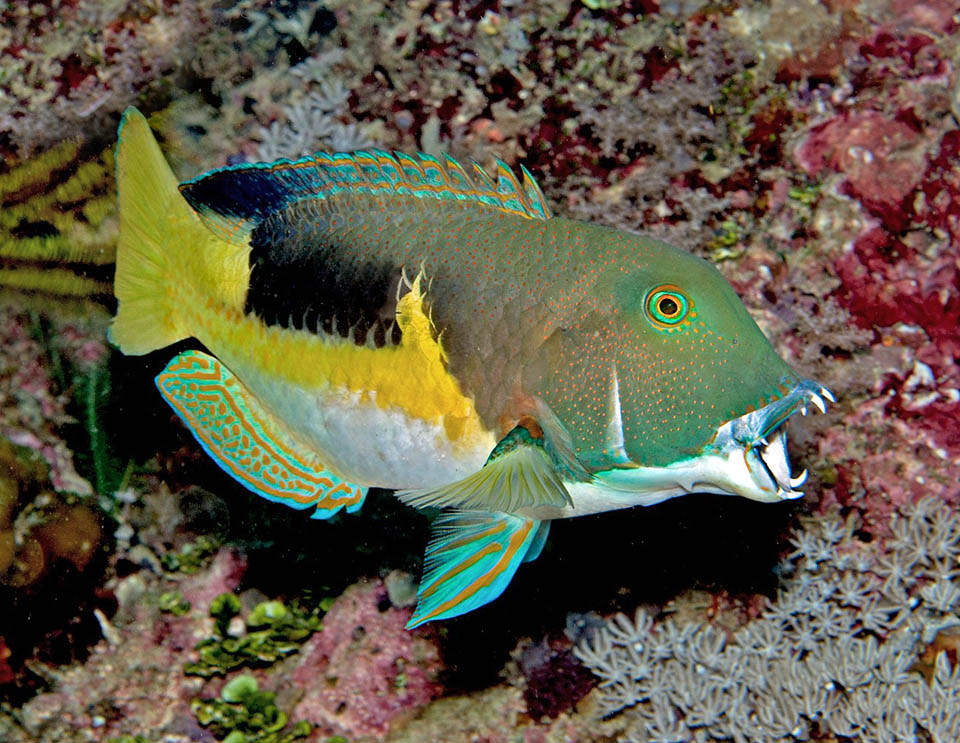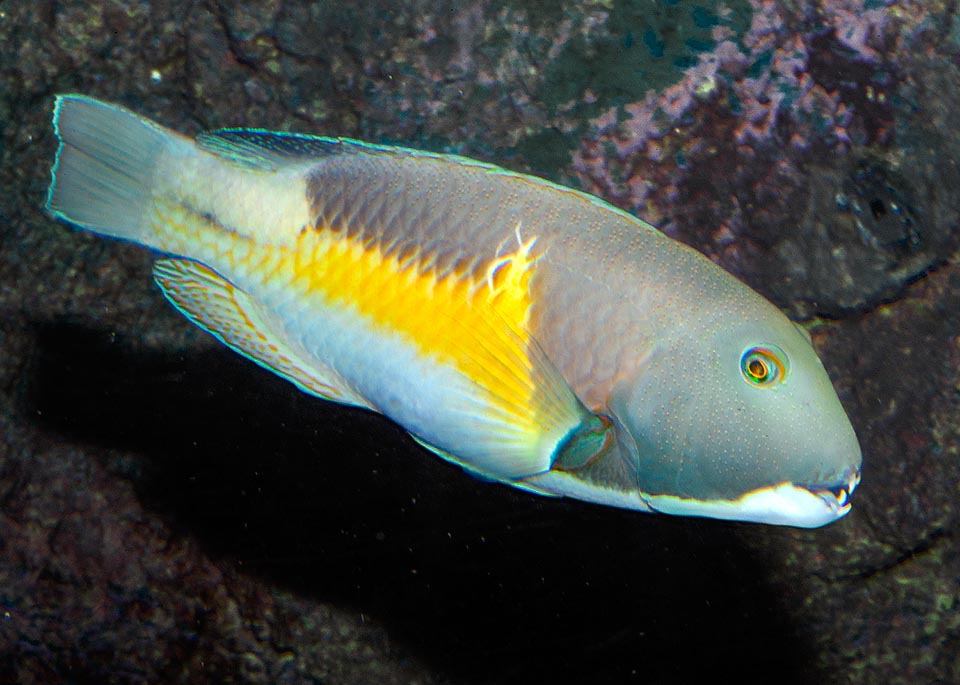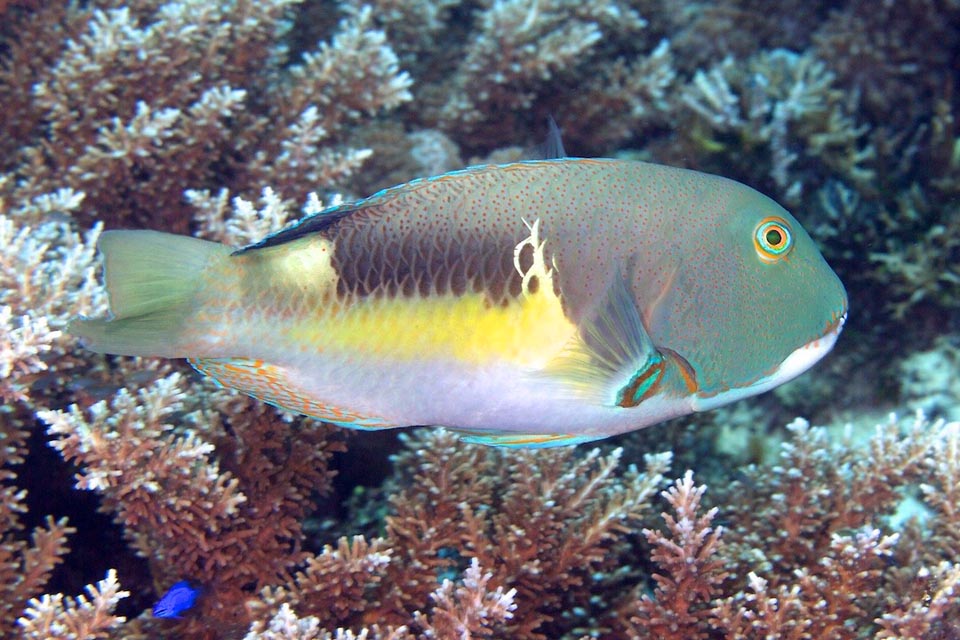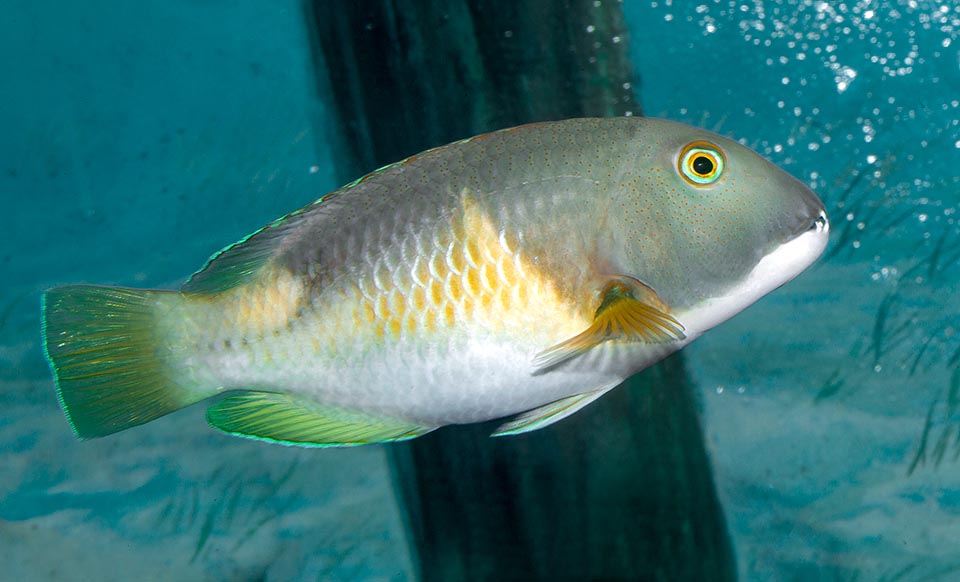Family : Labridae

Text © Giuseppe Mazza

English translation by Mario Beltramini

Spectacular Choerodon anchorago attacking. The name of the genus refers to the protruding canines that evoke those of the wild boars © Anna & Ned DeLoach
Choerodon anchorago (Bloch, 1791) belongs to the class of the Actinopterygii, the ray-finned fishes, to the vast order of the Perciformes and to the multicoloured family of the Labridae, presently (2020) rich of 71 genera and 549 species, with surprising liveries often linked to showy sexual dimorphisms and changes of sex.
The name Choerodon, assigned to 26 species of the family, comes from the Greek term“Χοιρός” (khoiros) = pig, pork and “ὀδών” (odon) = tooth, with reference to the protruding canines that somewhat evoke those of the wild boars. The specific term anchorago, seems to refer to the unusual drawing it has on both sides, looking like an anchor.
Zoogeography
It is present in tropical Indo-Pacific. Indicatively, we find it in India and in Sri Lanka, the Andaman Islands, in Thailand, Malaysia, Indonesia, Palau Islands, Papua New Guinea and Australia. Northwards, is present in the Philippines, Vietnam, China, Taiwan and Ryukyu Islands in southern Japan. Towards south-west we find it in Micronesia, in the Vanuatu Islands, in New Caledonia, which mark the southern limit of the species, whilst eastwards it has colonized Tonga, Niue and French Polynesia.

Fished small for the aquaria and adult for the fish market, Choerodon anchorago can be 50 cm long in the tropical Indo-Pacific © Giuseppe Mazza
Ecology-Habitat
It lives among the madrepore formations not beyond the 25 m of depth. It swims in the seagrass meadows, in sandy zones, often among rocls and madrepore remains, but also on the external slope of the reefs between madrepores and soft corals. The young are frequent in the estuaries and among the roots of the mangroves where they find food and shelter.
Morphophysiology
The Choerodon anchorago can reach the half metre of length with a relatively stocky body. The profile of the head, convex over the eyes, displays four scaring protruding canines. The dorsal fin has 12-13 spiny rays and 7 soft. The anal has 3 spiny rays and 9 unarmed. The pectoral ones, translucent yellow, show 15-16 soft rays and the caudal fin is more or less truncated.
The livery is a “Picasso painting”. The body seems broken in two parts by by a vertical more or less intense yellow, yellowish to orange, band extending in a triangle widening towards the ventral zone, white up to the tail.

Apart small dots and arabesques, the yellow-black contrast, at times intense, breaks usually the outline mimicking the head, while the pale tail distracts and confuses predators. Intelligent fish that uses tools to break the bivalves it’s greedy of, throwing them several times on a particular stone of its territory used as hammer © Allison & Carlos Estape
Aloft, on the sides and the back, the livery is greyish-greenish finely spotted of orange towards the head and very dark towards the tail, where it forms a neat black square reduced to a simple horizontal stroke at tghe base of the white and yellowish saddle of the lower back.
The dorsal fins tend to be of a greenish colour spotted with a small green-blue border, as in the anal that, conversely, is yellow with orange patterns. The pectoral ones are yellowish and the pelvic with orange and blue bands. At the base of the pectoral fins stands a large blue-blackish spot. It should be added, however, that depending on the location and the mood of the fish, all these colours may also be very faded.
Ethology- Reproductive Biology
The Choerodon anchorago nourishes of all what it can find, at the cost of overturning with its teeth small rocks and fragments of madrepores on the bottoms. It looks for, and often finds on the hidden face, molluscs, crustaceans, small worms, starfishes and small sea urchins. It has been noted that at times it breaks the shell of the bivalves throwing them repeatedly against a rock, used, surprisingly, then, as a tool, like a hammer.

Reproduction occurs in group with eggs abandoned to the currents. The young often grow among the mangrove roots where they get abundant food and hideaways © Giuseppe Mazza
The young swim in small schools whilst the adults, territorial, live mainly alone apart during the reproduction period, usually between January ans March, when take place the group weddings with eggs entrusted to the currents.
Fished for the aquaria, but mainly for the local fish markets, the Choerodon anchorago is unfortunately losing membres. Theoretically, the population may double in 1,4-4,4 years, but they are often far apart, and the fishing vulnerability index of the species marks already 40 on a scale of 100.
Since 2009, Choerodon anchorago has been listed as “LC, Least Concern” in the IUCN Red List of endangered species.
Synonyms
Sparus anchorago Bloch, 1791; Labrus macrodontus Lacepède, 1801; Cossyphus macrodon Bleeker, 1849; Choerops meleagris Rüppell, 1852; Labrus chlorodus Gronow, 1854; Crenilabrus leucozona Bleeker, 1858; Choerops maeander Cartier, 1874; Choerodon weberi Ogilby, 1911.
→ For general information about FISH please click here.
→ For general information about BONY FISH please click here
→ For general information about CARTILAGINOUS FISH please click here.
→ To appreciate the BIODIVERSITY of BONY FISH please click here.
→ To appreciate the BIODIVERSITY of CARTILAGINOUS FISH please click here.
